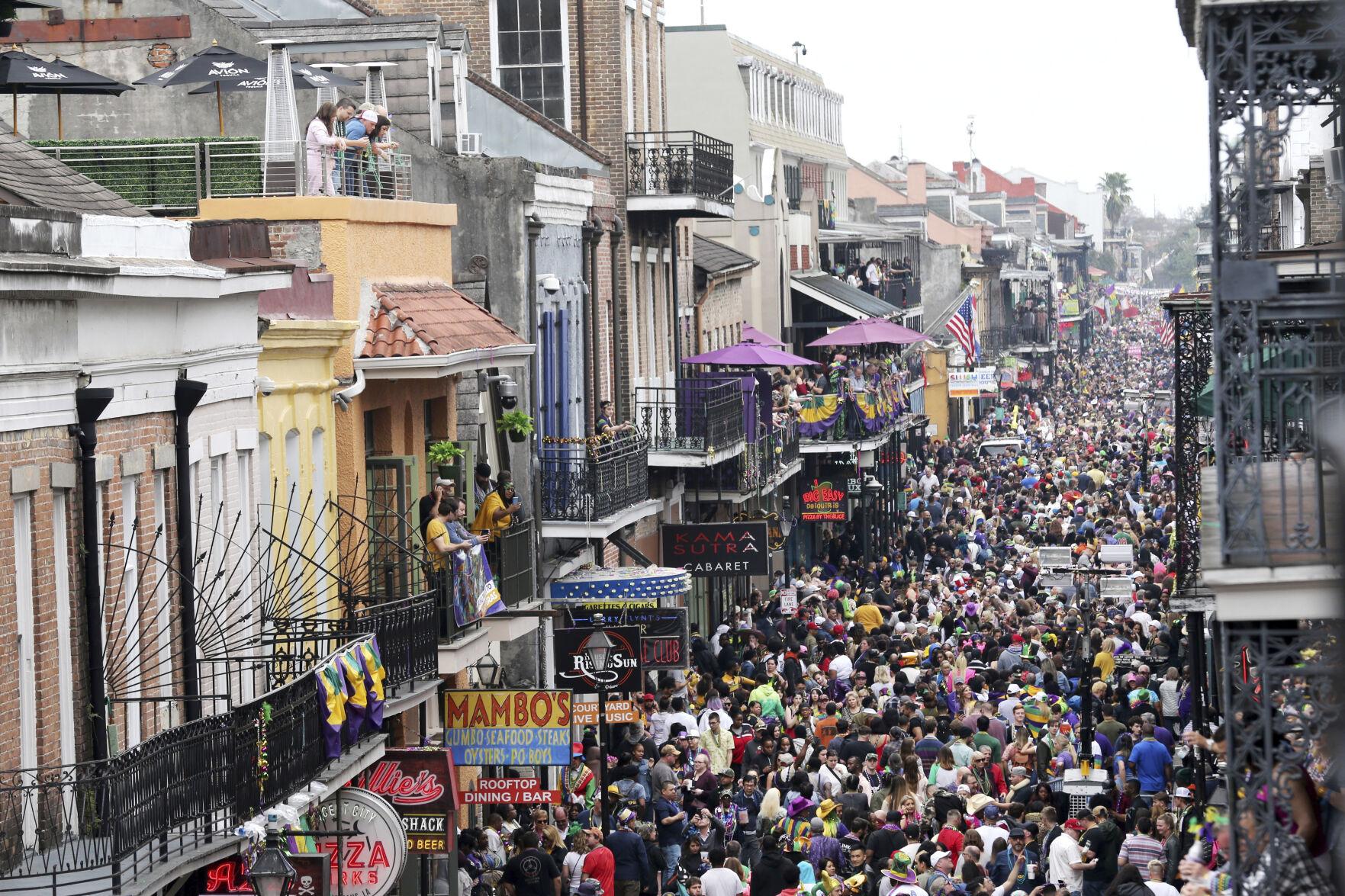Blog
Mardi Gras and the weekend leading up to it will look quite different in New Orleans this year amid the lingering coronavirus pandemic.
Mayor LaToya Cantrell announced new restrictions starting next Friday, Feb. 12, and lasting through the Mardi Gras holiday on Feb. 16 as part of a citywide plan to crack down on crowds to prevent the spread of COVID-19.
The biggest new restriction? The closing of all bars in the city. Also included were guidelines on where people can and cannot gather during the time the rules are in effect.
All New Orleans bars closed for Mardi Gras, access restricted to major streets under new rules
- CITYWIDE: All bars will be closed for indoor and outdoor service; the sale of to-go drinks is not allowed.
- FRENCH QUARTER: The sale of packaged liquor will be prohibited.
- BOURBON STREET*: Bourbon Street will be closed at night from 7 p.m.-3 a.m. to both vehicles and pedestrians. Loitering is not allowed.
- FRENCHMEN STREET*: Frenchmen Street will be closed at night from 7 p.m.-3 a.m. to both vehicles and pedestrians. Loitering is not allowed.
- DECATUR STREET*: Decatur Street will be closed at night from 7 p.m.-3 a.m. to both vehicles and pedestrian with no loitering allowed.
- CLAIBORNE CORRIDOR: The Claiborne Underpass will be fenced off from St. Louis Street to St. Bernard Avenue and loitering is not allowed. Large gatherings are banned including things that encourage people to congregate, like street performances.
- OTHER: NOPD Superintendent Shaun Ferguson said there will be an increased police presence at the above locations, along with Magazine Street and St. Charles Avenue.

Written by Earl King
more...This cluster, known as M53 and cataloged as NGC 5024, is one of about 250 globular clusters that survive in our Galaxy. Most of the stars in M53 are older and redder than our Sun, but some enigmatic stars appear to be bluer and younger. These young stars might contradict the hypothesis that all the stars in M53 formed at nearly the same time. These unusual stars are known as blue stragglers and are unusually common in M53. After much debate, blue stragglers are now thought to be stars rejuvenated by fresh matter falling in from a binary star companion. By analyzing pictures of globular clusters like the featured image taken by the Hubble Space Telescope, astronomers use the abundance of stars like blue stragglers to help determine the age of the globular cluster and hence a limit on the age of the universe. M53, visible with a binoculars towards the constellation of Bernice’s Hair (Coma Berenices), contains over 250,000 stars and is one of the furthest globulars from the center of our Galaxy.

Milton “Milt” Holland (born Milton Olshansky; February 7, 1917 – November 4, 2005) was an American drummer, percussionist, ethnomusicologist, and writer in the Los Angeles music scene. He pioneered the use of African, South American, and Indian percussion styles in jazz, pop and film music, traveling extensively in those regions to collect instruments and learn styles of playing them.
Holland was born Milton Olshansky in Chicago, Illinois, where he attended Theodore Roosevelt High School. His first instrument was the violin. He pursued a passion for percussion, playing in clubs and shows and on CBS Radio in Chicago. By the age of twelve, he was playing at speakeasies for the likes of Al Capone. In the early 1940s, Holland toured and recorded with The Raymond Scott Orchestra. He studied tabla at UCLA and with Ramnad Easwaran. In India, Holland studied with tabla master Chatur Lal beginning in 1963. He traveled through India extensively in the early 1960s and 1970s, then spent many years in Africa studying tribal rhythms. He was among the first to introduce the instruments to western recording.
After moving to Los Angeles in 1946, he played on countless jazz and pop albums, film and TV scores. A sampling of the artists he worked with includes Frank Sinatra, Bing Crosby, the Beatles, the Rolling Stones, Chaka Khan, John Williams, Leonard Bernstein, Elmer Bernstein, Quincy Jones, Nat King Cole, Henry Mancini, Loggins and Messina, James Taylor, Ella Fitzgerald, Laurindo Almeida, Ry Cooder, Bonnie Raitt, Seals and Crofts, Ray Manzarek, Michael Dinner, Gordon Lightfoot, Ringo Starr, Kenny Loggins, Jim Messina, Poco, Captain Beefheart, David Blue, Rita Coolidge, Carly Simon, Cal Tjader, the Doobie Brothers, Little Feat, Maria Muldaur, Randy Newman, and Joni Mitchell. He played pandeiro, congas and triangle on Mitchell’s hit Big Yellow Taxi and congas and percussion on Light My Fire with José Feliciano.
more...
Curtis Ousley (born Curtis Montgomery; February 7, 1934 – August 13, 1971), known professionally as King Curtis, was an American saxophonist who played rhythm and blues, jazz, and rock and roll. A bandleader, band member, and session musician, he was also a musical director and record producer. Adept at tenor, alto, and soprano saxophone, he played riffs and solos on hit singles such as “Respect” by Aretha Franklin, and “Yakety Yak” by The Coasters and his own “Memphis Soul Stew”.
Curtis Montgomery was born in Fort Worth, Texas, the son of Ethel Montgomery, and was adopted, with his sister Josephine Allen (died 2019), by Josie and William Ousley. Curtis attended I.M. Terrell High School, and studied and performed music with schoolmate Ornette Coleman.
Curtis was stabbed on August 13, 1971, during an argument with a pair of drug dealers he discovered on the steps outside his Manhattan apartment. Curtis was attempting to carry an air conditioner into his apartment when Juan Montanez refused to move from the entrance. A fight ensued and Montanez stabbed Curtis. Curtis was transferred to Roosevelt Hospital, where he died.
more...Earl Silas Johnson IV (February 7, 1934 – April 17, 2003), known as Earl King, was an American singer, guitarist, and songwriter, most active in blues music. A composer of blues standards such as “Come On” (covered by Jimi Hendrix, Freddy King, Stevie Ray Vaughan) and “Big Chief” (recorded by Professor Longhair), he was an important figure in New Orleans R&B.
King was born in New Orleans, Louisiana, United States. His father was a piano player. He died when Earl was still a baby, and Earl was brought up by his mother. With his mother, he started going to church at an early age. In his youth he sang gospel music, but he took the advice of a friend to switch to blues to make a better living.
King started to play the guitar at the age of 15. Soon he started entering talent contests at local clubs, including the Dew Drop Inn. At one such club he met his idol, Guitar Slim. King started imitating Slim, and his presence had a big impact on his musical direction. In 1954, Slim was injured in an automobile accident (right around the time he had the number 1 R&B hit “The Things That I Used To Do”), and King was deputized to continue a tour with Slim’s band, representing himself as Slim. After succeeding in this role, King became a regular at the Dew Drop Inn.
His first recording was made in 1953. As Earl Johnson, he released a 78-rpm record, “Have You Gone Crazy”/”Begging at Your Mercy”, for Savoy Records. The following year, the talent scout Johnny Vincent introduced King to Specialty Records, for which he recorded some sides, including “Mother’s Love”, which was locally popular. In 1955, King signed with Vincent’s label, Ace. His first single for that label, “Those Lonely, Lonely Nights”, was a hit, reaching number 7 on the Billboard R&B chart. He continued to record for Ace for the next five years. During that time, he also he started writing songs for other artists, such as Roland Stone and Jimmy Clanton.
more...James Hubert “Eubie” Blake (February 7, 1887 – February 12, 1983) was an American pianist, lyricist, and composer of ragtime, jazz, and popularmusic. In 1921, he and his long-time collaborator Noble Sissle wrote Shuffle Along, one of the first Broadway musicals to be written and directed by African Americans. Blake’s compositions included such hits as “Bandana Days”, “Charleston Rag”, “Love Will Find a Way”, “Memories of You” and “I’m Just Wild About Harry“. The 1978 Broadway musical Eubie! showcased his works.
Eubie Blake was born February 7, 1887, at 319 Forrest Street, in Baltimore, Maryland. Of the eight children born to former slaves Emily “Emma” Johnstone and John Sumner Blake, he was the only one to survive infancy. John Blake was a stevedore on the Baltimore Docks.
Blake claimed in later life to have been born in 1883, but records published beginning in 2003—U.S. Census, military, and Social Security records and Blake’s passport application and passport—uniformly give his birth year as 1887.
Blake’s musical training began when he was four or five years old. While out shopping with his mother, he wandered into a music store, climbed on the bench of an organ, and started “foolin’ around”. When his mother found him, the store manager said to her, “The child is a genius! It would be criminal to deprive him of the chance to make use of such a sublime, God-given talent.” The Blakes purchased a pump organ for US$75.00, making payments of 25 cents a week.
more...NGC 7822 is a young star forming complex in the constellation of Cepheus. The complex encompasses the emission region designated Sharpless 171, and the young cluster of stars named Berkeley 59. The complex is believed to be some 800–1000 pc distant, with the younger components aged no more than a few million years. The complex also includes one of the hottest stars discovered within 1 kpc of the Sun, namely BD+66 1673, which is an eclipsing binary system consisting of an O5V that exhibits a surface temperature of nearly 45,000 K and a luminosity about 100,000 times that of the Sun. The star is one of the primary sources illuminating the nebula and shaping the complex’s famed pillars of creation-type formations, the elephant trunks.

Natalie Maria Cole (February 6, 1950 – December 31, 2015) was an American singer, songwriter, and actress. Cole was the daughter of American singer and jazz pianist Nat King Cole. She rose to success in the mid-1970s as an R&B singer with the hits “This Will Be“, “Inseparable” (1975), and “Our Love” (1977). She returned as a pop singer on the 1987 album Everlasting and her cover of Bruce Springsteen‘s “Pink Cadillac“. In the 1990s, she sang traditional pop by her father, resulting in her biggest success, Unforgettable… with Love, which sold over seven million copies and won her seven Grammy Awards. She sold over 30 million records worldwide.
Natalie Cole was born at Cedars of Lebanon Hospital in Los Angeles, to American singer and jazz pianist Nat King Cole and former Duke EllingtonOrchestra singer Maria Hawkins Ellington, and raised in the affluent Hancock Park district of Los Angeles. Regarding her childhood, Cole referred to her family as “the black Kennedys” and was exposed to many great singers of jazz, soul and blues. At the age of 6, Natalie sang on her father’s Christmas album The Magic of Christmas and later started performing at age 11.
https://www.youtube.com/watch?v=AnQTGdEHpIM
more...Robert Nesta Marley, OM (6 February 1945 – 11 May 1981) was a Jamaican singer, songwriter, and musician. Considered one of the pioneers of reggae, his musical career was marked by fusing elements of reggae, ska, and rocksteady, as well as his distinctive vocal and songwriting style.Marley’s contributions to music increased the visibility of Jamaican music worldwide, and made him a global figure in popular culture for over a decade. Over the course of his career Marley became known as a Rastafari icon, and he infused his music with a sense of spirituality. He is also considered a global symbol of Jamaican music and culture and identity, and was controversial in his outspoken support for the legalization of marijuana, while he also advocated for Pan-Africanism.
Born in Nine Mile, British Jamaica, Marley began his professional musical career in 1963, after forming Bob Marley and the Wailers. The group released its debut studio album The Wailing Wailers in 1965, which contained the single “One Love/People Get Ready“; the song was popular worldwide, and established the group as a rising figure in reggae. The Wailers subsequently released eleven further studio albums; while initially employing louder instrumentation and singing, the group began engaging in rhythmic-based song construction in the late 1960s and early 1970s, which coincided with the singer’s conversion to Rastafarianism. During this period Marley relocated to London, and the group embodied their musical shift with the release of the album The Best of The Wailers (1971).
The group attained international success after the release of the albums Catch a Fire and Burnin’ (both 1973), and forged a reputation as touring artists. Following the disbandment of the Wailers a year later, Marley went on to release his solo material under the band’s name. His debut studio album Natty Dread (1974) received positive reception, as did its follow-up Rastaman Vibration (1976). A few months after the album’s release Marley survived an assassination attempt at his home in Jamaica, which prompted him to permanently relocate to London. During his time in London he recorded the album Exodus (1977); it incorporated elements of blues, soul, and British rock, enjoyed widespread commercial and critical success.
In 1977, Marley was diagnosed with acral lentiginous melanoma; he died as a result of the illness in 1981. His fans around the world expressed their grief, and he received a state funeral in Jamaica. The greatest hits album Legend was released in 1984, and became the best-selling reggae album of all time. Marley also ranks as one of the best-selling music artists of all time, with estimated sales of more than 75 million records worldwide. He was posthumously honored by Jamaica soon after his death with a designated Order of Merit by his nation. In 1994, he was inducted into the Rock and Roll Hall of Fame. Rolling Stone ranked him No. 11 on its list of the 100 Greatest Artists of All Time.
more...John Pisano (born February 6, 1931) is a jazz guitarist born in Staten Island, New York. Pisano has worked with Herb Alpert, Billy Bean, Chico Hamilton, Peggy Lee, and Joe Pass.
more...More Posts
- Daily Roots Paddyrasta
- Son Bonds
- Cosmo Venus Eclipse
- Minoru Miki
- Ramzan Paskayev
- Fred Neil
- Tommy Flanagan
- World Music Sinéad O’Connor
- Daily Roots Sky Nation
- Ralph MacDonald
- Cosmo Blood Moon Lunar Eclipse Pi Day
- Phil Lesh
- Sly Stone
- Ry Cooder
- Charles Lloyd
- “Lightnin'” Hopkins
- World Music Zar Electrik
- Daily Roots Prince Jammy
- Happy Holi Festival of Colors 2025
- Happy Pi Day 2025

